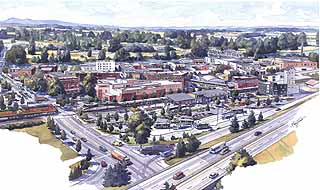|
Subscribe / Renew |
|
|
Contact Us |
|
| ► Subscribe to our Free Weekly Newsletter | |
| home | Welcome, sign in or click here to subscribe. | login |
Construction
| |
 |
September 16, 2004
Skagit Station offers hope for renewal
Arai Jackson Ellison Murakami

Image courtesy of J. Craig Thorpe/The Discovery Institute
Mount Vernon chose a downtown site for its new transit center, citing its central location, freeway access and visibility from Interstate 5.
|
The new Skagit Station in Mount Vernon delivers true multimodal transportation to a rapidly growing region. In the next few months, commuters and travelers will be able to converge on a central location in downtown Mount Vernon to switch between Skagit Transit bus, Greyhound bus, Amtrak rail and local taxi.
Population growth
Many wonder why such a small, rural area would be blessed by a $7.8 million transportation center. The answer lies in projected population growth for Skagit County. Between 1990 and 2000, the county grew from 79,000 residents to 103,000, nearly 30 percent growth. By 2020, estimates are that the population of the county will grow to 130,000, according to the state Office of Financial Management.
Transportation options alleviate traffic congestion and will help revitalize downtown Mount Vernon.
"A multimodal station provides a central location for local and regional bus, rail, and taxi, which enhances each mode of transit," said former Mayor Skye Richendrfer, a longtime proponent of the project who lobbied Congress to get federal funding for design and construction.
"Bringing people through downtown will increase transit ridership, as well as create a new front door to the city and play a central role in the revitalization of Mount Vernon's core."
Revitalization of the Skagit Valley region with real transportation options for the public can help alleviate urban sprawl problems. Proponents of the station hope to see development and increased economic activity as residents and tourists come through downtown Mount Vernon to visit different parts of the county and surrounding region.
Getting the train started
The project obtained initial funding in the mid-1990s, when different sites were being looked at in Burlington and Mount Vernon. One of the catalysts was the reemergence of Amtrak in the Northwest, and with the federal government offering grants to deserving projects.
|
Former Mayor Richendrfer lobbied in Washington D.C. for funds to get the station development started. With many organizations and agencies involved in the project, the funding was split between different agencies, including Skagit Transportation, the city of Mount Vernon, a Transportation Improvement Board grant, the Washington State Department of Transportation, Amtrak, and the largest percentage from the federal government.
The downtown Mount Vernon location was selected due to its central location, freeway access and visibility from Interstate 5. The station will also be seen as a catalyst for the improvement to downtown, spurring economic development and housing closer to the core. With a convenient transition point in the center of town, residents and visitors alike can utilize a variety of modes of transportation to local ferries, airports, attractions such as the tulip fields, and the Skagit River.
The design process
Arai Jackson became involved in the station after a site selection study was completed in the mid-1990s that identified a location for the station.
The first chosen site was on College Way due to its connection to a planned Skagit Transit maintenance facility that was subsequently relocated to another site. The second site was on Kincaid Street in downtown Mount Vernon.
The change of site moved the station into an urban area with many open parcels, decaying buildings, and small businesses. To assemble the required land necessary for the station, properties needed to be acquired at fair market value and a lengthy environmental process had to be completed. Arai Jackson managed the process of assembling the property for the city within guidelines issued by the Federal Transit Authority while completing the station design in phases.
Traditional features
The new station relates to the timber and brick materials of Mount Vernon's historic downtown and the train platform is directly across the tracks from Mount Vernon's original station.
The entry way as well as the roof overhangs are supported by wooden beams called kick braces, a traditional railroad station feature. The spacious entry lobby provides direct access to the platform as well as offices, a community meeting room and amenities for travelers.
The structural timber supports are exposed throughout the station adding visual interest and honesty to the construction. The roofs extend at both ends of the station as well as along the platform and entry façade providing weather protection and shading on all facades.
Site amenities include civic assembly areas, native plantings and pedestrian connections to other modes of transportation and the city infrastructure.
The station was dedicated on Aug. 24 after several tumultuous years in development. Amtrak began service on Sept. 13.
Looking into the future
While public transportation is not yet used by a very large percentage of Skagit County residents, project boosters see this project as a forward-looking part of the transportation infrastructure. As residents learn that each mode of transportation connects at Skagit Station, ridership should increase.
Future development is already planned. The city's chamber of commerce and visitor's center will become a permanent tenant in the station, allowing for great public access.
As some of our regional transportation projects struggle under heavy budgets and divided constituents, Skagit Station serves as an example of solving a long-term problem.
"We had to be strategic with seeking funding and getting community partners together," said Richendrfer.
"We fought tenaciously and got support from multiple agencies and now have a wonderful new gateway to the city."
Bruce Ellison is a partner at Arai Jackson Ellison Murakami, an architecture, urban design, and interiors firm.
Other Stories:
- A cheaper way to treat runoff
- Light-rail line hits fast forward
- Staving off the pitchforks and torches
- Creating a seamless regional transit system


